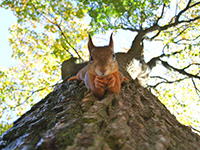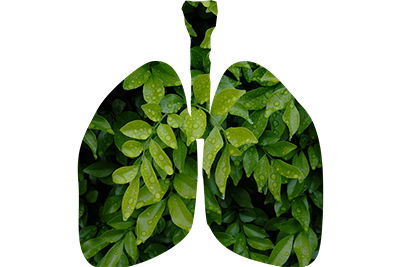Trees are beneficial in so many ways. We’ve discussed using trees as windbreaks, planting ornamental trees for visual embellishments, and saving money on energy bills by using the shade that trees provide to your advantage. In addition to all the great things trees do for us, they do even more for nature and wildlife. From food and shelter to cleaning our air and storing carbon, trees and tree service in Monmouth County support nature and wildlife.
Birds, Squirrels, and Other Animals Appreciate Trees
 Providing a habitat is one of the top advantages of trees in nature. Birds, squirrels, and many other animals turn to trees to be their homes. Canopies of deciduous trees can help protect inhabitants from predators and escaping into a tree eliminates threats that can’t climb or fly. Plus, trees are a great place to raise young for many creatures.
Providing a habitat is one of the top advantages of trees in nature. Birds, squirrels, and many other animals turn to trees to be their homes. Canopies of deciduous trees can help protect inhabitants from predators and escaping into a tree eliminates threats that can’t climb or fly. Plus, trees are a great place to raise young for many creatures.
In addition to that, trees and shrubs supply the animals that enjoy them with food. Berries, seeds, fruits and nuts are the primary source of nutrition for many wildlife. Even leaves and flowers feed birds and other animals. Aside from trees themselves providing food, they are also home to many bugs and insects that are the main food supply of woodland creatures.
In order for the trees in your yard to continue to offer all these benefits, contact us for your tree service in Monmouth County.
Trees and Tree Service in Monmouth County Benefit the Earth
Healthy trees and their roots help aerate soil allowing more nutrients to be delivered to the soil and the living things planted in it. In addition to that, decaying leaves and tree bits increase the level of nutrients in the soil by creating natural compost. This improves soil biodiversity which directly improves the health of the lawn and trees growing in that soil.
Sturdy root systems also help to prevent erosion. As soil gets washed away, the nutrients held within it goes away too. Soil also helps absorb rain and water reducing flooding and wash-out. By slowing the flow rate, erosion is greatly reduced. Without roots to hold on to the soil, it can get swept in bodies of water polluting it. To get the healthiest roots, make sure you provide your trees with professional tree service in Monmouth County.
Homeowners keep house plants for a variety of reasons, but one of them is because plants help clean the air. If small house plants can improve the indoor air quality of a home, consider the impact that trees have around the world. This is why maintaining healthy trees worldwide are so crucial. Removing pollutants like carbon dioxide is essential to sustaining life on earth. But trees don’t just filter out toxins. Through photosynthesis, they also produce oxygen by converting carbon dioxide in the environment.
Our Trees Service in Monmouth County Supports the Environment
 As trees take in carbon dioxide and expel oxygen, they store the extra carbon in their trunks. The larger the tree, the more carbon it can store. This is why taking care of trees is so important. We need large, mature, healthy trees to treat our air and provide so many other benefits.
As trees take in carbon dioxide and expel oxygen, they store the extra carbon in their trunks. The larger the tree, the more carbon it can store. This is why taking care of trees is so important. We need large, mature, healthy trees to treat our air and provide so many other benefits.
By trimming certain branches off of a tree, the weight of the top of the tree is changed. If you remove too many limbs on one side, the tree will become too heavy on one side and is likely to uproot. This is why professional tree service in Monmouth County by a licensed tree company is so essential. Trees provide so many benefits. The catch is that they can only do that if taken care of properly. Contact us today if you have trees in your yard that could use a little TLC.
 Using the appropriate fuel is essential in the safe usage of any fire apparatus. This month, we’re going to be focusing on firewood in Waretown and the entire Jersey Shore. Wood burning stoves and fireplaces are very popular amenities in homes located in any environment that experiences freezing temperatures. Ocean County certainly has experienced some cold winters. With the addition of a wood burning stove or fireplace, you can reduce your energy usage and bill, improve your indoor ambiance, and have a reliable source of heat in case of power outages. Plus, they add value to your home because they are so desirable. If you do have a fireplace, proper usage is essential for safety. Selecting the right wood, building an efficient fire, and having your chimney cleaned yearly are just some of the “rules” of correct wood burning stove use.
Using the appropriate fuel is essential in the safe usage of any fire apparatus. This month, we’re going to be focusing on firewood in Waretown and the entire Jersey Shore. Wood burning stoves and fireplaces are very popular amenities in homes located in any environment that experiences freezing temperatures. Ocean County certainly has experienced some cold winters. With the addition of a wood burning stove or fireplace, you can reduce your energy usage and bill, improve your indoor ambiance, and have a reliable source of heat in case of power outages. Plus, they add value to your home because they are so desirable. If you do have a fireplace, proper usage is essential for safety. Selecting the right wood, building an efficient fire, and having your chimney cleaned yearly are just some of the “rules” of correct wood burning stove use.
The Best Woods for Burning Indoors are Dense
The first step, picking the right wood, is one of the most important decisions to make before starting a fire indoors. For a fireplace or wood burning stove, firewood should be dense. This means hardwoods make an efficient firewood because they provide more wood to burn per piece than lighter, more hollow wood. Some good types of hard, dense woods are Hickory, Birch, and Red and White Oak. Soft wood is better for outdoor fire pits. They are easy to light making them perfect for kindling, but can produce more smoke than hardwoods which is why they are preferable for outdoor use. Some popular soft woods for outdoor fires are Cedar, Pine, and Spruce.
What to Avoid When Selecting Firewood in Waretown
When discussing firewood, you will often hear the term green wood. But, what does this mean? Unseasoned wood is also referred to as green wood. This wood is recently cut and, therefore, has a high moisture content. Fresh wood should not be used, especially indoors because of this high moisture. Moisture produces more smoke which produces more creosote in your chimney.
Creosote is a highly flammable substance that is a normal side-effect of fires. An annual chimney cleaning will keep this dangerous build-up at bay keeping your fireplace safe. When purchasing firewood in Waretown, avoid green, or unseasoned, wood at all costs unless you are planning on storing it for next season.
Moisture Content for Firewood in Waretown
For the safest use of your indoor fireplace, the moisture content of the wood should be below 20%. Using a wood higher in moisture content than that can cause an unsafe amount of creosote to build-up in your chimney. This is especially important for smaller chimneys like those for wood burning stoves. Burning wet wood can result in an amount of creosote that can block a chimney in one season. This leads to chimney fires, smoke blow back, and other dangerous situations. An easy way to test your wood for it’s moisture content is with a moisture meter.
Proper Firewood Storage
Ideally, firewood would be stored outdoors, cleanly stacked, and left uncovered. This allows for the best airflow around the wood allowing it to dry out. During rainy or snowy seasons, however, leaving wood uncovered is not always an option. When it is necessary to cover firewood in Waretown, use an appropriate wood cover rather than a tarp or another material that doesn’t allow air flow. Avoid leaving your firewood under a lot of other trees and never leave it in a pile. Using a wood rack or pallet is also helpful to allow for air to circulate all around the wood.
